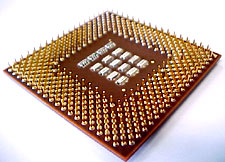Already holding the speed crown, AMD decided
to "one up" Intel once more with the release of the AthlonXP
2000+ CPU. With the XP2000+ retailing for approx. $540 and the Pentium4 2.0 GHz for
around $830, we weren't too happy to have to buy one these P4's for this review,
but, it's all in the name of testing, so let the dual begin!
The AthlonXP processor incorporates quite a few new
"features" that it's older brother the Athlon doesn't have. Most notably the
Quanti-Speed Architecture. What exactly is Quanti-Speed you ask? Well, first off it's really more
of a marketing ploy then anything else, and essentially says that "our
CPU's do more work per clock cycle, so MHz means nothing now." Still, there
are some true enhancements from the Athlon core. Probably the biggest
enhancement was the inclusion of Intel's SSE
technology . Yes,
that's the same technology which is inside every Pentium III
processor.
Streaming SIMD (Single Instruction
Multiple Data) Extensions were also added to allow
the Athlon XP processors to handle multiple data calculations at
one time. Still, with all this great technology, it's only really useful
if the software programmers code for it. Fortunately for AMD, SSE
has been around for quite some time now, so there are quite a few pieces of
professional software already using it. Not surprisingly AMD chose to call
it 3DNow! Professional rather than SSE.
Next in the line of additions to the Athlon XP is hardware prefetch, which
is built into the "Palomino" core (AthlonXP and AthlonMP). What
hardware prefetch does is look at what the user is doing and try to extrapolate
what piece of data is going to be used next. The processor stores that
prefetched data in the L1 data cache, thereby increasing the speed of
calculations when that data is needed. If it turns out to be wrong, it
willl simply flush the cache and get the data that's actually required.
While this is
not part of the Quanti-Speed Architecture, one very significant addition the XP
has is the inclusion of a internal thermal diode. This isn't anything
new to Intel dies, which have had the benefits of internal
thermal diode's since the Pentium II 'Deschutes' core. Like Intel,
AMD seems to be having a hard time getting motherboard manufacturers to
read the temperatures from the internal diode rather than an external one however.
Until the manufacturers start to follow through
on this, the horror stories of burnt-out processors will continue to be heard.
The packaging:
When
AMD introduced the Athlon XP on the OPGA (organic pin grid array) substrate
they alleviated many of the problems seen by some Athlon
and Duron owners (overzealous heatsink application could crack the processor in
two). The move to fiberglass packaging made allowances for
some flexing during heatsink installation and also improved processor performance by lowering impedance.
The Athlon XP follows in this tradition, and for the moment, the substrate is still
brown.
Expect to start seeing the green Athlon XP's by May or June of this
year.

AMD XP model numbers:
Almost each and every company that manufactures processors
has been trying to find ways of educating the consumer about the dangers of relying
entirely upon the "MHz Myth." This started with Transmeta and their Crusoe
processor, and AMD has recently embraced this mantra.
As far
as AMD is concerned, ever since the introduction of Intel's Pentium4 line of
processors, you could no longer compare Intel MHz directly to AMD MHz. This discrepancy arose
because the Pentium 4 has longer pipelines which allow the Pentium4 to
scale significantly higher then it's competition.
AMD has since started the True Performance Initiative
(TPI). This has received mixed reviews from consumers who often see the XP model
numbers as an attempt to be misleading, but this really isn't the case. What the
XP model numbers are trying to communicate is the relative application
performance. The real goal is base "performance" ratings on IPC (Instructions
executed Per Clock cycle) x MHz =
TPI.
AMD has been working with many larger OEM's
such as Compaq, HP and Sony to try and create a appropriate performance
rating system. But for the moment, this quote from the AMD Athlon XP
FAQ explains it best: "The AMD Athlon XP processor 1900+ will outperform an Intel Pentium
4 processor operating at 1.9GHz...." The Athlon XP 2000+ by the way,
operates at a frequency 1.67 GHz.
- Athlon XP 2000+ operates at 1.67 GHz
- Athlon XP 1900+ operates at 1.60 GHz
- Athlon XP 1800+ operates at 1.53 GHz
- Athlon XP 1700+ operates at 1.47 GHz
- Athlon XP 1600+ operates at 1.40 GHz
- Athlon XP 1500+ operates at 1.33 GHz
Pure Gaming Bliss:
Even though AMD produces some of the most powerful x86 based processors, they're still
preceded with the reputations of the K6, K6-2, K6-III based processors of being
slow and full of compatibility problems. This just isn't the
case for the Athlon based CPU's, in fact they're quite a bit more powerful
then their Intel counterparts! Long gone are the days of lousy 3D gaming/professional
performance, now they're the king of the hill with the Athlon
based CPU's.
One nice thing is
that AMD unlike intel, has never locked the multiplier of their CPU's so
the enthusiasts have always been able to push their CPU's
to the fullest. Sure changing the multiplier is more difficult then before, and it
would probably deter those amature's overclockers who would possibly ruin their CPU's, but
it's still possible to adjust them! It just takes a little
more work.

